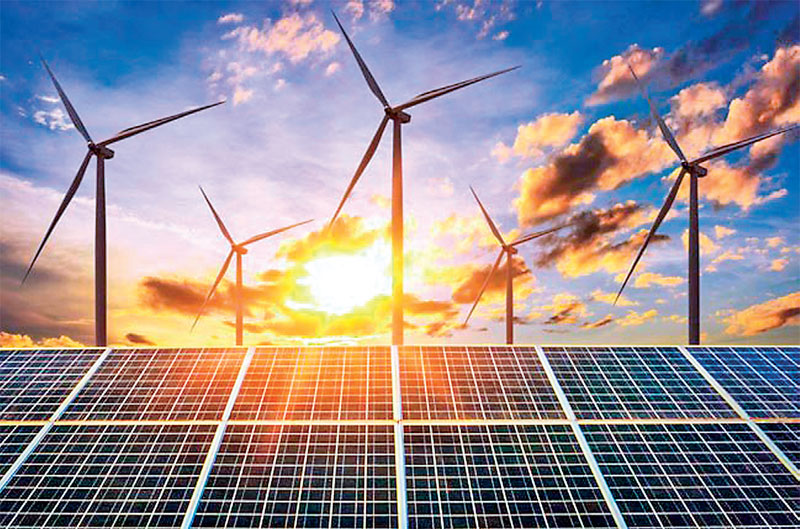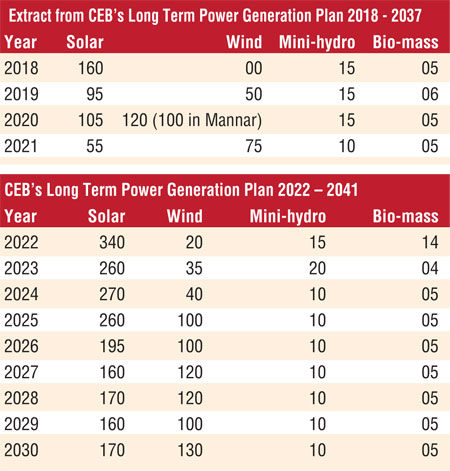Thursday Oct 30, 2025
Thursday Oct 30, 2025
Monday, 31 January 2022 00:11 - - {{hitsCtrl.values.hits}}

|
 The country is facing a situation similar to late 1990s, with some forecasting four-hour power-cuts, but CEB Engineers Union forecast 1.5-to-9-hour power-cuts. The President at a meeting with Minister Gamini Lokuge ordered no power-cuts, but for how long? The situation could worsen by March/April when hydro reservoirs run dry.
The country is facing a situation similar to late 1990s, with some forecasting four-hour power-cuts, but CEB Engineers Union forecast 1.5-to-9-hour power-cuts. The President at a meeting with Minister Gamini Lokuge ordered no power-cuts, but for how long? The situation could worsen by March/April when hydro reservoirs run dry.
Power-cuts are blamed on the inability of Ceylon Petroleum Corporation to fulfil fuel demands of CEB, with most power plants running on imported fuel. Last year with exceptionally heavy rainfall, the country had no issues, hydro-power reservoirs were full and ran 24 hours. With dry-season inflow got reduced and water levels are coming down. The heavy downpour last year could result in a long dry season possibly till May/June, worsening power issues during the hottest period.
History
After the Accelerated Mahaweli scheme’s multiple hydro-power plants by the mid-1980s, the country had excess electricity and politicians boasted of exporting to India. Their boasts were short-lived with power-cuts by early 1990s, reaching six hours in a few years. The Government’s invitation for power generation was grabbed by the private sector. The Government signed 10-to-20-year power purchase agreements at exorbitant prices.
As a long-term measure the Government proposed large coal power plants, but dragged on with disputes over locations and finally Norochcholai was selected. First unit of coal plant generated electricity in 2011, but faced frequent breakdowns. Units 2 and 3 were commissioned by 2014.
Although several proposals were made for LNG based power, less polluting than coal, only power plant materialised was the 300 MW Yugadanavi by Lanka Transformers Ltd., a subsidiary of CEB, capable of running on LNG, but continuing to run on diesel at a higher price. The plant came on-line in 2015.
In 2016, the Government called for proposals to construct a 300 MW LNG based power plant in Kerawalapitiya. After a long delay the tender was awarded in mid-2021.
Although wind and solar based power plants started since 2010, low contribution is due to poor attention given by CEB. President Gotabaya in his election manifesto proposed 80% renewable energy by 2030, but later revised it to 70%. But the implementation is very slow.
Renewable energy
Electricity generated from hydro-power, wind, solar and bio-energy are referred to as renewable energy (RE). The country’s hydro power sources are almost exhausted, except for small power plants developed by local companies, but stopped by CEB over the past seven years. Wind and solar power have enormous potential, initial investments are slightly higher than thermal, running costs are low, without imports.
Solar is during the day, wind throughout day and night, but wavering over months as well. Highest electricity demand is from 6:30 to 9:30 p.m., thus solar could meet the day time demand with hydro contributing to higher night demand. To balance the demand batteries could be used, presently expensive but prices expected to come down soon.
 Wind power
Wind power
From the Middle Ages Europe had windmills, which were extended to generate electricity. Hambantota wind farm 3 MW capacity owned by CEB commissioned in 1999, but was dismantled in late 2018.
A World Bank report of August 2007 identified nearly 5,000 sq. km with good-to-excellent wind resource potential of 24,000 MW. About 4,100 sq. km of land and 700 sq. km in lagoons, largely concentrated in the north western coast from Kalpitiya Peninsula north to Mannar Island, Jaffna Peninsula also central highlands.
CEB accepted wind farms on “first-come, first-served” basis resulting in 15 privately owned wind power plants by 2014 producing 127 MW, constructed by six companies and ten were over 10 MW. But the system was suspended in 2014 claiming underhand dealings.
In November 2019, CEB called for proposals for 60 MW wind power plants of 1-10 MW capacity on BOT basis. CEB overlooked that existing wind power plants, by private investors, were over 10 MW.
CEB installed a 103 MW wind power plant in Mannar Island with ADB assistance, and started production in 2021.
Wind passing over Strait of Mannar
A strong stream of wind passes through the Strait of Mannar. Using the same State of Tamil Nadu installed six wind power projects, becoming the leader in India producing 7,450 MW. Of these, Muppandal Wind Farm is the largest in India, 1,500 MW capacity, spread over villages showing the ability of wind farms for peaceful co-existence with villagers.
Mini-hydro and biomass power
For a number of years CEB has blocked approving mini-hydro and biomass power producers, demanding them be tendered, irrespective of the established law of feed-in tariffs. The refusal was the Attorney General’s interpretation of the law that tenders need to be called. Although solar projects and mini-hydro projects under 10 MW were allowed earlier, the sudden decision prevented progress.
Sri Lanka Bio-Energy Association claims dendro-power projects of nearly 100 MW have been blocked since December 2015.
Rooftop solar
Sri Lanka Sustainable Authority (SLSEA) introduced rooftop solar power units in 2010 became a success. The electricity produced was purchased at Rs. 22 for 7 years and Rs. 15.50 for 13 years. Over five years, 6,000 domestic solar rooftops added 31 MW to the national grid.
Surya Bala Sangramaya
The success resulted in the ‘Battle for Solar Energy’ (‘Soorya Bala Sangramaya’) in 2016 with the target of establishing one million rooftop solar systems adding 1,000 MW to the main grid. Under the project, the power produced would be purchased by CEB under three systems: 1. Net metering system: (original system), 2. Net accounting and 3. Net plus.
Changes to the system
Earlier, SLSEA accepted solar power produced by small private producers up to 5 MW. Since January 2016, CEB blocked all NCRE projects.
In June 2017 under Sooryabala Sangramaya Phase II, CEB called bids for 60 solar power plants of 1 MW capacity at 20 locations. Out of 63 bids received, 36 were accepted under rates of Rs. 12.73 to Rs. 18.37 per unit, averaging Rs. 17.22. The prices displayed the reduced costs of solar power production, in dry regions with low rain and cloud cover.
Small Solar Producers Association protests that 617 prospective producers registered with SLSEA and having paid over Rs. 100 million were denied by CEB to install 1-5 MW power projects with 1,555 MW capacity.
Minister Ravi Karunanayake announced that from August 2019, only Net Plus would be in place. Under the same, rooftop solar producing up to 50 KWs would be paid a Rs. 19.75 flat rate for 20 years while systems above 50 KWs are paid Rs. 18.75.
Patali Champika Ranawaka
Under the Yahapalanaya government, Patali Champika Ranawaka an Electrical Engineer from University of Moratuwa became the Minister for Power and Energy, but only from January to August 2015. He presented the ‘Sri Lanka Energy Sector Development Plan for a Knowledge-based Economy, 2015-2025’. The plan proposed to increase generation capacity to 6,400 MW by 2020, develop renewable power as bio-mass, mini-hydro, solar and wind-power to generate 1,114 MW. If he continued the ministership, most of the current power generation issues would have been addressed.
CEB obstructions to power generation
In 2014 CEB deliberately obstructed implementing wind power projects developed since 2010. Meanwhile, politicians failed to give policy support to renewables. With political support, wind power capacity would have reached 1,000 MW by now, eliminating the power crisis. Now, CEB wishes to call tenders claiming the least cost principle is applied.
1. CEB stopped approving solar rooftops in the north and east, claiming grid connections are not available. When customers apply for solar connectivity, face higher application fees and refuse accepting capacity over 50 KW.
2. When 617 prospective producers registered to produce up to 5 MW totalling 1,555 MW, CEB called tenders under 1 MW totalling 60 MW, near grid stations, generally located in a suburb; also, small productions make overheads higher. Even under these conditions 36 investors tendered and CEB accepted submissions averaging Rs. 17.22. The process took two and a half years.
3. For wind power, tenders were called for 1 to 10 MW for a total of 60 MW. If tenders were called for 5 to 20 MW, the country would have got over 200 MW less than Rs. 12 a unit.
4. CEB, by a circular dated 8 April 2021, obstructed solar projects on roofs of commercial establishments, limiting the capacity to maximum power consumed during the last six months. Meaning commercial establishments need to wait one year after commencement of operations. CEB overlooked that most factories and hotels have their own transformers, collecting excess power would help CEB.
Government’s lethargy
The President’s policy during elections promised to generate 80% (later changed to 70%) of the country’s electricity from renewable energy sources by 2030. The policy was agreed at a President’s meeting with the State Ministry of Solar, Wind and Hydro Power Generation Projects Development and the Power Minister.
However, the Section 5 of Sri Lanka Electricity Act, No. 20 of 2009, to give effect to a policy decision, the policy needs Cabinet acceptance. The Secretary to the Power Ministry needs to draft the Cabinet paper and submit for approval. Once approved, needs incorporation in General Policy Guidelines of the Electricity Industry and gazetting. Thereafter, PUCSL will direct the CEB to comply with the new policy guidelines.
Finally, the Cabinet of Ministers cleared the proposal only in September 2021. Until then, CEB engineers were able to refuse and delay acceptance of RE projects.
CEB’s policy planning
For over a decade CEB has been publishing its Long-Term Power Generation Plan as per government policy for acceptance of PUSCL. Thereafter, acceptance of power projects is based on the Plan. Until 2015 solar and wind power were not even mentioned in the Plan.
Figure 1 shows the 2018-2037 plan, when private investors produced 127 MW in 2014 through wind power projects, allocation for 2018 was zero.
Even with the CEB’s plan for 2022-2041 prepared with the new government in power, there is no substantial increase in RE production. But allowed 300 MW coal plants, also 2,358 MW of oil and LNG powered plants, completely ignoring the President’s 70% renewable energy policy.
CEB refused to entertain solar and wind power plants proposed by private investors claiming the investments are not according to CEB’s accepted Policy. But after the government policy gazetted in September 2021, PUSCL may have instructed CEB to revise LTPG Policy.
CEB engineers’ corrupt practices
When electricity was purchased from Private Power Producers (PPPs) the purchase price included capital and running costs. After ending the contract period, the purchase price is continued the same, thus allowing space for corrupt practices. Also, coal is imported by a company under CEB. RE development was obstructed to allow room for corrupt practices of CEB engineers.
The front page of a Sunday Sinhala newspaper reported that a Malaysian Company had filed a case with an Arbitration Authority in Singapore alleging that the permit given by CEB to establish wind and solar power plants were cancelled. An officer has demanded a sum of $ 2 million from the Malaysian company and the refusal led to cancellation of permit. The incidence shows the bribery within project approvals.
Urgency of renewable power
The country is threatened with power cuts with insufficient oil due to foreign exchange shortages. The country’s maximum demand is around 2,800 MW. If wind power producers were allowed to continue after 2014, by now they would be producing over 1,000 MW. If solar power development was not restricted Small Solar Producers Association members would be producing an additional 1,500 MW. Solar power could fulfil a substantial quantity of day-time need, saving water for the night demand. If the 2,500 MW from wind and solar were allowed, entire thermal power would be redundant, at least theoretically. There would be no power shortages and a large percentage of oil imports could be averted, saving foreign exchange. Thus, for the country’s forward march wind, solar and bio-energy projects suspended by CEB for years need to be implemented immediately. Problem would be how?
An efficient minister
The Minister of Power and Energy needs to be an efficient person understanding intricacies of power generation. The only MP within the government capable of handling the Power and Energy ministry is Nalaka Godahewa, with a BSc Honours degree from University of Moratuwa in Electronics and Telecommunication Engineering and a PhD in economics. His experience in the business sector would allow him to understand the issues.
Way forward – Emergency law
Now, the President’s RE policy has been gazetted, CEB need be instructed to amend its LTPGP accordingly and immediately. Also, the Electricity Act needs revision removing restricting clauses on RE development.
The country is facing a Power Emergency and the President needs to bring in an Emergency Law by-passing current CEB’s restrictions. Also, legislation for an “Emergency RE Development Plan”, valid for three years only, under the Emergency Law. In addition, a “Project Committee” be appointed under the Minister, with authority to approve power projects. The Committee included CEB engineers, but not the majority.
The tendering system for RE be removed for proposals within 10 MW of solar and 20 MW of wind. The proposal made by Ravi Karunanayake offering Rs. 16 for solar below 10 MW and Rs. 12 for wind below 20 MW, be implemented with rates adjusted to devaluation of Rupee to Dollar. To encourage investors for early implementation, they could be offered additional Rs. 2 for power generation within the first year and a Rupee for second year.
The Project Committee needs to allow 617 registered to produce up to 5 MW totalling 1,555 MW. Also, the investors who have submitted proposals over two years ago will be accepted immediately. For projects over above the rates could be negotiated by the Project Committee depending on the quantity and the location. Also, foreign investors such as Indian company Adani need to be negotiated and accepted early.
Setting up a Project Committee alone will not eradicate problems among developers, CEB engineers are extremely shrewd, and would device means to obstruct and delay new projects.
For new projects detailed project proposals demanded by CEB could be replaced with short proposals. Proposals with issues are returned within two weeks and others are accepted within one month.
CEB claims they were forced to hold back RE Projects due to unavailability of grid connections. Also, more solar power at non-peak hours cannot be handled by the national grid. Thus, CEB needs to lay required power lines. CEB’s technical issues are not confined to Sri Lanka and have been resolved in other countries. Thus, the President could seek help from India for technical assistance.
Few years ago India signed an agreement offering $ 200 million for solar development. In addition, the Government signed a loan agreement in September 2018 with ADB for $ 59.8 million, could be used to import solar panels.
Meeting the power challenge
If the President could implement the proposal given above, reducing the project acceptance period, electricity generation from new RE projects would start in six months, with the possibility of reaching 60% electricity from RE sources in three years, allowing the Power Emergency to be lifted.
Afterwards, solar projects of over 10 MW and wind over 40 MW only be accepted, enabling electricity to be delivered below Rs. 10 a unit, meanwhile roof-top solar could continue. The progress would allow most fuel powered generation plants to be discontinued, making CEB to run at a profit. In five years, the country could reach 80% RE energy as promised in the President’s original proposal.